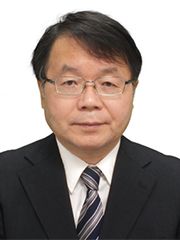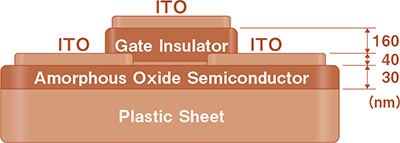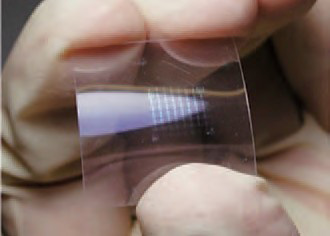Research Results
Triggered by the transparent oxide semiconductors IGZO-TFT
A Revolution in Flat Panel Displays FY2017

- Hideo Hosono (Professor, Materials and Structures Laboratory / Director, Materials Research Center for Element Strategy, Tokyo Institute of Technology)
- ERATO
- "HOSONO Transparent ElectroActive Materials" Research Director (1999-2004)
- SORST
- "Exploring and Developing Applications for Active Functions Utilizing Nanostructure Embedded in Transparent Oxides" Research Representative (2004-2010)
- ACCEL
- "Materials Science and Application of Electrides" Research Director (2013-2018)
Breaking new ground with revolutionary new materials
Apresent, a great many PCs and televisions feature liquid crystal dis-A plays, and the world market for the TFT(Thin Film Transistor) panels used in these displays to be around 10 trillion yen. Howev-er, several problems exist with the amorphous silicon semiconductors cur- rently used as a main component in TFT liquid crystal displays. As technol-ogy continues to evolve toward more advanced functionality, the capabilities of these semiconductors will not be able to keep pace.
Consequently, one technology that has gained increasing attention is Transparent Amorphous Oxide Semiconductors (TAOS), developed by Professor Hideo Hosono at ERATO and SORST. One of its materials, TFT (hereinafter referred to as IGZO-TFT*), has been invented using In-Ga-Zn-O (an oxidized material consisting of indium, gallium and zinc) by Professor Hosono's group. Development of these semiconductors has en-abled subsequent accelerated research into their practical applications now underway by corporations bothin Japan and overseas, thus taking development of TFT liquid crystal technology to a completely new level.
In May 2011, Professor Hosono was commended for his outstanding achievement in the Jan Rajchman Prize by the Society for Information Display (SID) in recognition of his successful discovery of TAOS. More-over, he was given an honor the"Motto Lecture Award"by International Conference on Amorphous Semiconductor in 2013. Upon receiving the award, Professor Hosono commented,"It is revolutionary new materials that enable us to break new ground," emphasizing to the world the impor-tance of materials research. In 2016, Professor Hosono was recognized for his achievements in his"creation of unconventional inorganic materials with novel electronic functions based on nanostructure engineering"in the"Materials and Production"field, and was awarded the Japan Prize.
As semiconductors for next-generation TFT panels, TAOS gains worldwide attention!
TAOS have a range of advantages in comparison with conventional amorphous silicon semiconductors. Firstly, they possess electron mobility up to 50 times higher than previously possible. Conven-tional amorphous silicon semiconductors with lower electron mobility will be unable to handle the demanding requirements of future televisions, such as 3D and large screen functionality. Also, as the release of various new devices continues, the development of flexible TFT will also take on increasing sig-ni cance. TAOS, which can be flexible on substrate, are particular e ective in this regard. Moreover, the TAOS thin film manufacturing process can be conducted at room temperature, which enables production at lower costs and reduced power consumption, making it altogether a dream material that has garnered attention form companies worldwide.

Constitution of flexible thin film transistor
10 years after TAOS disclosed: the Professor's revenge!
"Light passes through it, but electricity will not." Until Profes-sor Hosono presented his paper on TAOS at the 16th National Amorphous Semiconductor Conference in Kobe in 1995, this was the general understanding of glass among scientists. In truth, it would be more accurate to say they had absolutely no interest in it. There was almost zero reaction to Professor Hosono's findings; even worse, some even mocked him by suggesting that the conference was no place for a glass scientist to attend.
However, Professor Hosono refused to give up. At the time, in 1995, cathode ray tubes were far more mainstream than liquid crystal technol-ogy; certainly, no- one had predicted the modern demand for liquid crys- tal that would later emerge. This was evidenced by the fact that in the 8 years following 1995, Professor Hosono's findings on TAOS were cited a scant 4 times (of which 2 were self-citations). However, the climate of the times changed dramatically, and the demand for flexible electronics skyrocketed.In 2004, Professor Hosono's group successfully created a thin film transistor (TFT) on a plastic substrate using active layers of In-Ga-Zn-O, capable of approximately 20 times the electron mobility than the amorphous silicon previously used for displays, as reported in the journal Nature. (Also, crystal IGZO-TFT reported in the Science Journal in 2003) This paper was the first indication that a high performance TFT could be achieved using amorphous oxide semiconductors, and it made a major impact around the world (it has already been cited more than 2,500 times).
Moreover, in 2013, he was honored by that same conference bearing the name of one of its founders, Sir Nevil Mott, a Nobel laureate in physics. The originality of Professor Hosono was confirmed in both academic and technical aspects.

Since the thin film is manufactured onto a plastic substrate, it can be bent easily between the fingers.
Originality is the starting point of research
It is often said that apply materials research in a practical way takes at least10 years. The phrase "10 years"may roll off the tongue easily enough, but researching the same material for 10 year requires stubborn persistence. Up to this point in time, Professor Hosono has been maintaining ongoing research into glass, iron, con-crete and all manner of mundane materials, having achieved signifi-cant results in each.
The results that Professor Hosono has achieved so far in materials re-search have been most heavily influenced by his stance on research. In the environment of his graduate student days and even obtain employ-ment at lab, only research with a high degree of originality was ever properly recognized; thus, originality has always been Professor Hosono's starting point. In his earlier days, Professor Hosono came to understand that original research is work that would clearly never be done if the right person was not around and recognized by the world; and that research was a isolated job, pursuing something that no-one else is doing.
In 2012, high-precision displays driven by IGZO TFT technology were incorporated into new tablet PCs and low-energy smart phones, representing the long-awaited product launch of this technology. Then in 2014, this technology was also utilized in large-sized organic EL televisions.
*One type of TAOS. Named IGZO-TFT, formed by the initials of indium (In), gallium (Ga), zinc (Zn) and oxygen (O) used in this TFT.
